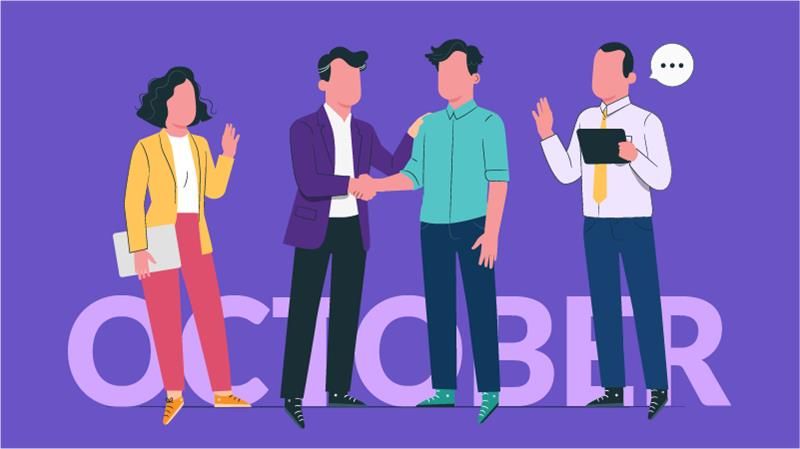5 Powerful Employee Engagement Strategies For The BFSI Industry

A Global Employee Recognition and Wellness Platform
No industry is perfect. But the Banking, Financial Services and Insurance (or BFSI) have an infamous reputation for being tough and challenging- more so for its employees.
And it makes sense.
Such intense work conditions make workers feel nervous, anxious, and vulnerable to burnout. When people go through this at work, it creates a sense of disengagement.
By disengagement, we mean when people feel demotivated, detached, or unhappy at work.
All in all, it's bad news for you because disengagement has the power to hurt your business's bottom line.
Don’t believe us? Let’s look at some numbers to cement our point.
Did you know that the BFSI industry has a dismal employee engagement rate of just 33%? Another survey unveiled that the BFSI industry has a 27.5% turnover in 2017, with 16.2% being voluntary turnover (i.e., people leaving of their own choice).
Leading (or even managing) people in the BFSI industry is not for the faint of heart. These HR leaders don’t get enough accolades for how hard it is to do it well.
If you are in such a leadership position right now, here are a few tips on engaging your people better:
These Are The Best Employee Engagement Strategies For The Banking, Financial Services and Insurance (BFSI) Sector
1. Corporate Social Responsibility (CSR) Initiatives
PwC found that:
61% of millennials in BFSI actively seek employers whose CSR values align with their own.
The above data speaks for itself.
To truly engage your people, a leader in the BFSI sector should not underestimate the power of giving.
In layman's terms, CSR, or corporate social responsibility, is when companies take serious steps to make a difference in society.
A typical day of a regular BFSI employee would be very hectic, stressed-filled, and heavy. Such actions can have a profoundly negative effect on the employees' minds.
To combat such feelings of unworthiness, loneliness, and anxiousness- CSR just might be the answer.
Today’s employees are more morally conscious about their social responsibilities. Being able to help others in need leads to their happiness and induces meaning in their lives.
Here are some examples of how leaders can further CSR initiatives:
- Forming meaningful relationships with the local community
- Contributing to social causes such as child drug abuse, homelessness, and many more.
- Extending support to international and local NGOs
- Establishing green HRM initiatives
- Rewarding and recognizing employees for taking up CSR initiatives
- While progressive companies saw how CSR influenced their millennial workforce, most are unaware of it.
By the way, did you know that by 2025 almost 75% of your workforce will consist of millennials?
Until companies re-focus on strong CSR efforts, they would find themselves dealing with an unhappy workforce.
2. Employee Wellness
While being in the BFSI industry sounds great on paper, the reality is far different. The pay, learning curve, and peer group are incredible, but BFSI jobs have their downsides.
The high expectations of these jobs mean that the stress attached to it gets a bit too real.
Burnout happens when people are at odds with their bodies and minds. It is common to see people undergo serious health issues due to the late hours, no work-life balance, and extra competitiveness.
Also, let’s not forget to address the elephant in the room. The Covid-19 pandemic.
Currently, health and wellness are vital factors in designing the ideal employee experience. No matter what type of industry you are from, employee wellness is one thing you can’t afford to ignore.
Simply put, employee engagement will occur only when you prioritize employee wellness.
People feel good at work when they feel psychologically safe, happy, and healthy. Thus, leaders should start recognizing employee wellbeing as a core company value.
We consider Deutsche Bank to be a great example of this.
Deutsche Bank believes employee wellness to be one of its four critical pillars of business success. The bank’s wellbeing practices go far beyond mental and physical. It also covers financial and social wellbeing. It is safe to say that they support a holistic approach to employee wellbeing.
But, simply talking about health and wellbeing is insufficient. Vital steps are needed to integrate it into the company culture fully. Here are a few of our personal favorites:
- Form a corporate wellness plan. Focus on its aim, strategies, cost, and implementation. Also, consider if you’ll be needing any corporate wellness provider or running it in-house.
- Advocate for mental health by taking strong actions. Hire a counselor, offer free meditation classes, gift subscriptions to mindfulness apps, etc.
- Promote lifestyle changes among your people. Offer health coverage, reward people for being fit, and set up workplace fitness contests.
3. Involve Employees In Decision Making
People working in the BFSI sector are highly skilled, value-based, and driven. These employees are highly career-oriented. They are always on the lookout to learn something new or gain new skills.
To engage such employees, leaders should consider decentralizing specific decision-making tasks. It means leaders can delegate part of their decision-making duties to competent employees instead.
When employees get the chance to make critical decisions, it makes them feel valued. It also means that they see themselves as part of the company's journey, which creates loyalty.
The simplicity of this strategy is that even the company reaps the benefits. Here’s how:
- When some new diverse people pitch in, it puts forward a set of ideas that you might not have thought of before.
- Employees grow more independent and confident. Creativity and innovation will flourish. Meanwhile, business processes will turn more efficient.
- It creates a sense of empowerment in people. Higher empowerment equals better engagement.
4. Mentoring
The BFSI industry is highly competitive. It is common to find people who are self-assured, skilled, and driven.
These traits may also intimidate a new hire or someone trying to advance in their career. Making your mark in the BFSI sector is hard when you are part of an underrepresented group.
Being circled by a high-achieving peer group can make a person doubt their abilities. Many people often quit because they get overwhelmed by the work and the environment.
Since the sector is very competitive, it helps when someone looks out for you and your interests.
Enter the mentoring system.
In other industries, it is a good engagement initiative. In the BFSI industry, it is potent.
Having a mentor with industry experience and advice on dealing with tough circumstances can be quite valuable for a mentee. Very often, the mentor becomes more than a professional guide. The mentee sees them as a life coach.
Engaging people is easier when they develop strong bonds with the people they work with.
A regular BFSI employee would greatly benefit from having a personal mentor to help them navigate their options, career path, and work. This initiative alone will reduce the amount of stress taken on by employees.
Also, let’s address another factor. Excellent mentors create good leaders.
If you ask any successful leader what their key to success is, they will almost always attribute it to their mentors. That is the extent to which the mentoring system can be successful.
5. Harnessing The Power Of Digitalization
Digital is 10% tech and 90% human. Organizations talk about digital as if it is 90% tech and 10% human.
~ Lucia Adams
The use of AI tools in HR functions has grown by leaps and bounds. These tools have made it possible to adopt global HR policies with little to no lag. Thus, managing engagement, performance, and productivity are less complex than they used to be.
Now that most companies have gone remote, HR leaders are focused on new ways to keep their employees happy without engaging in face-to-face meetings.
Remote employee engagement might seem like a difficult, costly, and time-consuming process. But it needn’t be.
For any HR leader hard-pressed to find a successful way to do so, here’s what to do. Implement an AI-driven employee engagement software or tool.
Any good digital employee engagement tool will focus on boosting your employees' happiness at work. Here are a few of them:
A more cost-effective option would be to find an all-in-one engagement platform like Vantage Circle.
What’s Next?
Engaging your employees is no easy feat. That is why we are here to help.
Vantage Circle brings you a cost-effective yet powerful AI-driven employee engagement platform with 4 targeted solutions. Be it rewards and recognition, employee benefits, pulse surveys, or employee wellbeing- we have a solution for you.
















